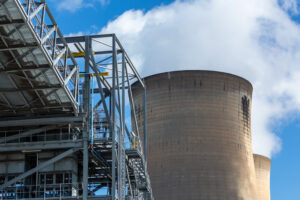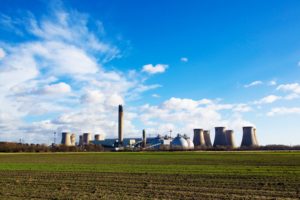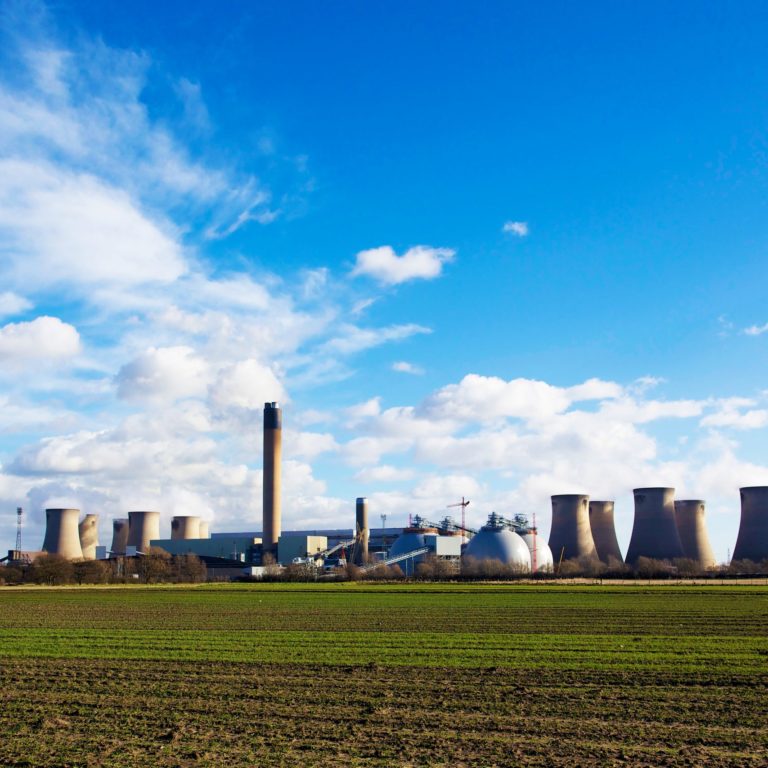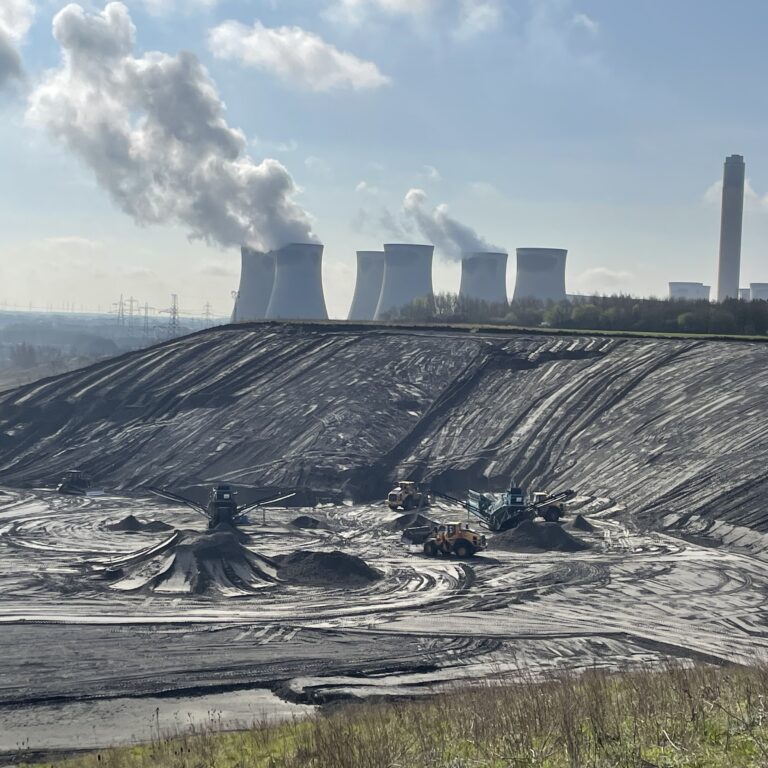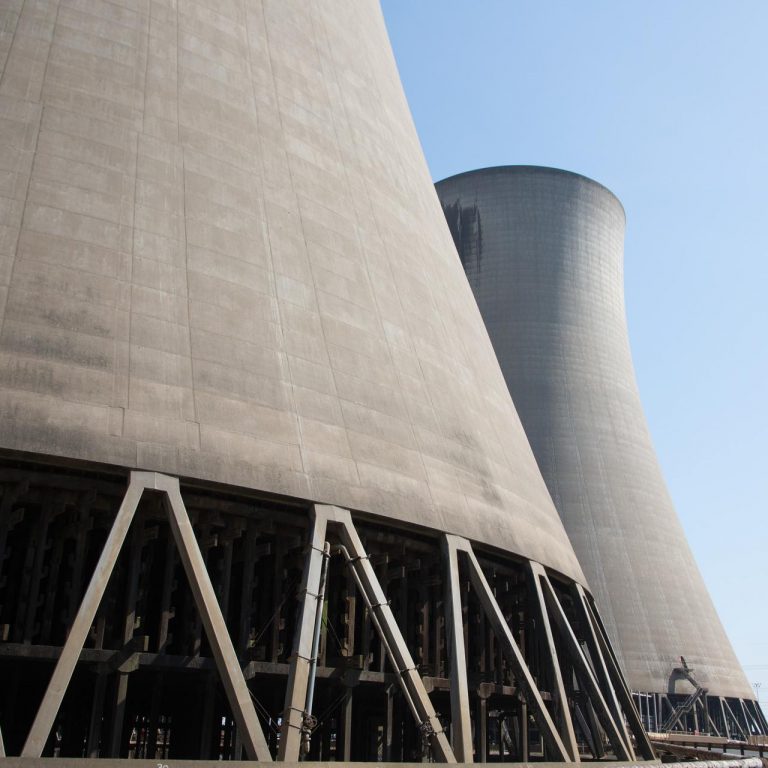50 years that have changed Britain’s energy
Chapter 1:
Introduction
50 years ago, if you were to stand on the southern slopes of the Peak District National Park and look out over the Trent Valley, the view before you would be markedly different from today. Arcing up through this stretch of England, you would see the chimneys and cooling towers of 13 coal power stations, generating electricity for homes and business up and down the country. It was termed Megawatt Valley.
“You could see these huge power stations in the distance with plumes of steam rising, like battleships moored out there,” says Bruce Heppenstall, Drax Power Station’s Plant Director, recalling a summer evening in the Peak District at the start of his energy career in the early 1990s.
These iconic landmarks of British energy don’t play the same role they once did. The power stations of Megawatt Valley have been closed, repurposed or demolished. Today, only one of those coal-powered giants that dominated the energy landscape remains open. Ratcliffe-on-Soar in Nottinghamshire, the UK’s last remaining coal power station, received its final fuel delivery on 1st July 2024. It officially closed on 30 September 2024, and will begin exploring low carbon hydrogen production. It’s a symbol of how drastically the country and its power system has changed, moving away from coal and towards innovation.
Drax Power Station sits further north at the western end of the Humber Estuary. When it first came online in 1974, it was the most advanced and efficient coal-fired power station ever built in the UK. In the 50 years Drax has been operating, Britain’s energy system has transformed – shaped primarily by the rapid decarbonisation of electricity generation that has been driven by a combination of government legislation, market economics and new technology. But perhaps the greatest change has been in the growing scientific understanding of the negative impacts of carbon dioxide (CO2) on the Earth’s climate and how this has shifted public opinion towards demanding a low carbon future.
While some of the challenges Britain faces today resonate with those felt in the 1970s, such as the need to ensure a secure, affordable supply of energy, other factors were scarcely considered. For years, sulphur dioxide and nitrogen oxide were the most-carefully tracked and mitigated emissions to prevent the threat of acid rain. Today, while those emissions are still carefully monitored and controlled, every sector of the economy is also focused on the need to reduce and remove CO2 emissions on a global scale. And through this past half century of dramatic change, Drax’s ability to innovate to adapt to the country’s changing needs have enabled it to remain a crucial asset in Britain’s energy system.
Chapter 2:
1970s and 80s: A centralised system dominated by coal
Britain in 1974 was a very different place from today. As families watched ABBA begin their path to worldwide fame by winning Eurovision, the political landscape was far less upbeat. The year would see two general elections, waves of strikes, rampant inflation, as well as escalating troubles in Northern Ireland.
Energy played a major role in shaping this tumultuous time for British politics and everyday life. Prime Minister Edward Heath’s inability to resolve the coal miners’ strikes at the start of 1974 forced the government to introduce a three-day week, whereby businesses could only operate and consume electricity for three out of seven days to conserve the country’s coal supplies.
The policy left people facing real hardship, towns and cities descended into darkness, candles became the main source of light, heating was limited to just one room, and water had to be boiled to wash in. Something had to be done, but the Prime Minister failed to find a satisfactory resolution with the striking miners. With no breakthrough in sight, Heath chose to call a general election. The result was a hung parliament, and so another election took place later in the year, which saw the opposition Labour Party gain a slim majority of just three seats.
It was against this backdrop of political instability and energy insecurity that Drax Power Station’s first electricity generating units came online. To a large extent, Drax was typical of power stations at the time, but it was also unique in several important ways.

“Drax was the biggest, most efficient facility in the UK,” says Heppenstall. “It was a time when size did matter. Its relative newness as the latest coal-fired power station made it a huge statement of centralised power production.
“It was simply twice the size of everything else. It was more efficient and was always the one that people in the industry wanted to work at.”
Although coal production had been in decline in the UK (having peaked in 1913), it was still the backbone of the energy system in 1974. Coal-fired generators accounted for 57.5 gigawatts (GW), almost 80%, of the UK’s total 72.1 GW of installed electricity generation capacity. Overall coal produced 172 Terawatt hours (TWh) over the course of the year, accounting for 63% of all electricity generated.
Oil and nuclear power made up the rest of electricity generation (20% and 11% of generation output, respectively), with minimal renewable power on the system. What renewable power there was came predominantly from hydroelectricity, which accounted for just 1.58% of UK electricity production, and included Drax’s pumped storage hydro plant Cruachan Power Station in Scotland – a region with a long history of developing hydropower.
Centralised control to meet demand
The electricity system was controlled centrally and based around large power stations that delivered baseload power.
“In the 1970s, the electricity system in England and Wales was all owned by the Central Electricity Generating Board (CEGB),” explains Iain Staffell, Senior Lecturer in Sustainable Energy at Imperial College London. “It controlled both the operating of the grid and all the investment, choosing what would be built, where and how to operate it.”
This picture of the UK’s electricity system may be quite different from today, where a diverse range of wind, solar, biomass, natural gas, nuclear, as well as imports via undersea interconnector cables, all owned and operated by private businesses provide the country’s day-to-day power. But the principal at the heart of the electricity system remains the same: balancing supply and demand.
All the electricity that’s used in homes, businesses, offices and factories is known as electricity demand. To ensure that the overall grid remains balanced, this demand must be met with the right supply of electricity every second of every day. If there’s too little electricity being generated to meet demand, blackouts can occur. Similarly, if there’s too much power on the grid at times when demand is low, the network becomes unbalanced, causing frequency and voltage fluctuations that can damage vital infrastructure and equipment.
In 1974, industries like manufacturing made up far more of Britain’s day-to-day demand, making it easy to predict and supply power at peak times. Generally, power consumption would be high during the day when factories and large businesses were using electricity. Demand might then spike just past 5pm as people arrived home and turned on lights, then drop again overnight when most people were sleeping.
This made coal and oil power stations well suited to meeting these peaks and troughs, as they could be turned on or off throughout the day. Nuclear power, which made up 11% of electricity generation in 1974, is much less flexible, delivering consistent levels of power to the grid, and is much slower to turn down or off.
Central control and planning were all in place for a stable electricity system. But that assumed that coal and oil could be easily sourced to fuel power generation. While the miners’ strikes curtailed coal production forcing it to be conserved, oil supply was facing its own challenges during the winter of 1973-74.
Impact of the oil crisis
Britain’s unique geology meant coal was plentiful, making it the fuel that powered the world’s first industrial revolution back in the 18th Century. But in an era of petrol vehicles and diesel trains, oil was the crucial propellant to both the UK economy and people’s everyday lives. In October 1973, in response to the UK and US’s support of Israel in the Yom Kippur War with neighbouring Arab states, the Organization of the Petroleum Exporting Countries (OPEC) began an embargo on exports. It sent shockwaves throughout the global economy.

“The cost of oil quadrupled, so it became completely uneconomical as an electricity source,” says Dr Staffell. “When oil was $3 a barrel it made sense as a fuel for electricity. But once the price rose closer to $20, it just couldn’t compete against coal.”
The shock of the crisis and sudden limitations of oil exposed Britain’s dependency on overseas fuels, placing a greater emphasis on the importance of coal, and power stations like Drax, in the electricity system.
When Drax Power Station’s second phase of construction was completed in 1986, its capacity was doubled to just under 4 GW, making it Western Europe’s largest coal-fired power station.
Coal was the bedrock of Britain’s electricity system. But change was coming. Over the course of the next 40 years, government policies, economics and new technologies would see coal completely phased out.
Chapter 3:
1990s: Shaking up the market
The electricity you use every day, to illuminate our homes, power our TVs and make our fridges hum, still works in the same way it did 50 years ago – the principles of meeting demand with supply still underlie how the electricity system works. But the company that you buy electricity from went through a radical change in the 1990s.
In its simplest form, the privatisation of the electricity system was about breaking up the CEGB – the entity that ensured electricity generation met demand and decided what kind of power stations and other infrastructure to build – into a number of private companies.
The 1989 Electricity Act enabled the selling of the industry to private shareholders. When the Act came into effect on 31st March 1990, the CEGB and every asset and power station it controlled was separated into three electricity generation companies: PowerGen, National Power and Nuclear Electric. The National Grid Company took over scheduling and directing power stations, while the company itself was owned by 12 local distribution companies.
The aim was to create a competitive market that would drive businesses to operate more efficiently and meet consumer demand at a lower cost, as well as spur new innovative ways to do so. For the UK government, market liberalisation served to reduce expenditure and generate income from the sale of electricity industry assets.

“Three utilities owned everything to start with, because that was the minimum number needed to create competition,” explains Dr Staffell.
“In the subsequent years they broke up, split, merged, and divested some of their assets. New players and international firms came on board. It was an organic process and it’s taken 30 years of liberalisation to get to where we are now, with lots of companies involved.”
Competing on power prices
Following privatisation in 1990, meeting electricity demand with the right level of supply also changed. The newly created National Grid Company now purchased power from different companies at the best possible price. Each morning, generators bid their plant’s available capacity to the National Grid Company. Winning bids then received their dispatch orders, and a set of half-hourly prices for the following day.
“Operating a power station became much more responsive to the market,” says Heppenstall. “If you didn’t, then you probably wouldn’t survive. Cost became a really big factor.”
Now controlled by revenue-driven businesses, power stations underwent an efficiency push to run as economically as possible to offer competitively lower electricity prices. The supply chains of coal power, which required mining and transporting the heavy fuel, made it a relatively expensive form of generation – especially compared to a new fuel that over the next few decades would come to replace coal and dominate Britain’s electricity.
The discovery of North Sea natural gas created the opportunity to deliver a comparatively cheap, abundant and less carbon intensive form of energy, both in industries that had once depended on coal and in electricity generation.
“The big change in the early ’90s was when the government relaxed the rules on burning natural gas for power production, launching what was called the ‘dash for gas’,” says Heppenstall. “The fuel costs were a lot cheaper, and efficiency was a lot higher.”
The private market found effectiveness and cost reductions thanks to newly developed, fast-acting, and fuel-efficient combined cycle gas turbines (CCGTs). These can rapidly respond to the needs of the grid, and so CCGTs introduced a new factor to the electricity market that would eventually replace coal as the backbone of Britain’s power system in the decades to follow.
The social effects of change
Privatisation had massively shifted how Britain’s energy system worked. It begun the process of introducing a wide range of new technologies and types of generation sources that would make up the electricity system that we have today. However, all this change came at a human cost.

“A lot of coal power stations had shut within a decade and that had a massive effect on the mining industry, because suddenly the demand for British coal had disappeared,” says Heppenstall.
Between 1980 and 1994, more than 200,000 miners lost their jobs. A failure to properly support the families and communities who were affected by this change should serve as a reminder today of the need for a just energy transition that fairly benefits people and society.
At the end of the 20th Century, gas accounted for 38% of the UK’s electricity generation, while coal contributed 30%. A stark contrast to 1990, when coal made up 62% of electricity output, and gas accounted for less than 2%. As natural gas produces around 50% less CO2 when combusted to generate electricity than coal, this shift was a key factor in beginning the decarbonisation of the grid, even if it was almost by accident.
“Decarbonisation was a side benefit. It was known about, but it wasn’t the core reason,” says Dr Staffell. “But it set the scene for being able to decarbonise the grid faster.”
Chapter 4:
2000s: Demand peaks and the stage is set for decarbonisation
The 1990s had seen private enterprise and the growth of gas power stations transform how electricity was generated and delivered to homes and businesses. But the 2000s saw the emergence of a trend in how Britain uses that electricity.
Following the recessions of the 1980s, Britain’s electricity demand steadily grew as the economy did: from 296 terawatt hours (TWh) per year generated in 1985 to 398 TWh in 2005. Then, something unexpected happened. Electricity demand, and subsequently generation, levelled out in the 2000s, and then began to steadily drop, down 15% in one decade to 339 TWh per annum in 2015. It remains at a similar level in 2025.
This transformation is surprising, especially considering how the country’s economy and overall population has continued to grow. But there are several factors that have quietly continued to lower the UK’s electricity demand.
“It’s partly the shift from heavy industry over to services, but a lot of it is from improvements in energy efficiency,” says Dr Staffell. “Flat screen TVs consume a tiny amount compared to the old cathode ray tubes. Lights are now LED and lots more people have stripped electric heating from their homes.”
The drop in Britain’s electricity demand has coincided with continued reductions of coal power and a growing understanding of the impact of CO2 on global temperatures.
This trend is not, however, expected to continue. Electrification will be key to decarbonising many sectors like transport in the form of electric vehicles, as well as industrial processes and heating. These new technologies are forecast to create significant new levels of demand on the electricity system over the coming years.
Climate consciousness, carbon budgets, and the emergence of renewables
Serious global political agreements about reducing emissions gathered pace in the 1990s, with the Kyoto Protocol coming into effect in 1997, committing industrialised countries to limiting their greenhouse gas emissions. The Intergovernmental Panel on Climate Change’s (IPCC) Third Assessment Report in 2001, also emphasised the human role in climate change.
How much the public understood climate change also reached a new level. The success of former US presidential hopeful Al Gore’s Oscar-winning documentary An Inconvenient Truth in 2006 helped bring the need to rapidly reduce CO2 emissions on a global scale into the mainstream. While environmental concerns around pollution from fossil fuels had existed since the 19th century, this realisation about the human impact on the planet’s climate brought a surge in demand for urgent action.
The greater media and public attention resulted in government action, with the 2008 Climate Act committing the UK to a 2050 target of reducing its greenhouse gas emissions by 80% compared to 1990 levels. The Act also led to the formation of the Committee on Climate Change and established UK carbon budgets.
“It put a price on carbon emissions, which again made coal relatively more expensive than gas power,” says Heppenstall.
Carbon pricing made the economics of operating coal power stations increasingly difficult, especially when gas now presented a much cheaper alternative. In a comparative market, where carbon emissions added to the overall cost of generating electricity with coal, it became increasingly uncompetitive, gradually pushing coal power stations off the power system.
Blyth offshore windfarm became the UK’s first renewable technology facility when it came online in 2000, with solar generators increasingly deployed throughout the decade. These still only accounted for a small portion of overall generation, but it marked the beginning of the rapid improvement and tumbling cost of the technologies that would enable more renewables to come online and help decarbonise Britain’s electricity in the decades to come.
With coal increasingly costly and uncompetitive, as well as greater awareness about the environmental impacts of its emissions, Drax Power Station began its transition to renewable, sustainable biomass. Drax Power Station had initially come under the ownership of National Power, but after a string of owners, Drax Group plc listed on the London Stock Exchange in 2005.

“It became a standalone plc and that allowed the company then to move into biomass when others wouldn’t have dared,” says Heppenstall. “It was incredible foresight and bravery by then-CEO Dorothy Thompson and the management teams to realise that operating on coal was only going to last a certain amount of time, and so began moving towards 100% biomass.”
Converting such a huge power station that had been designed to run solely on coal to operate using biomass presented substantial challenges. Drax had to undertake new learnings and exploration that included developing an understanding of sourcing, transporting and handling biomass, as well as carrying out extensive trials and testing of the alternative fuel in action. In 2009, Drax overcame the final challenges to successfully adapt its boilers to co-fire biomass wood pellets with coal, paving the way for a full transition away from coal to sustainable, renewable biomass.
Chapter 5:
2010s – today: The rise of renewables and visions of a Net Zero future
The transformation of the electricity system from 1974 to today has been defined by the move away from coal and the decarbonisation of the grid. Between 2010 and 2020, the carbon intensity of the UK’s electricity dropped 58%, from 450 grams per kilowatt hour (g/kWh) to 195 g/kWh.
“Government action has been a key driving force in the whole decarbonisation process,” says Dr Staffell. “The long-term stability of the Climate Change Committee and their carbon budgets setting targets many years into the future, mean that even if there’s short term variations in policies, there’s always an overarching target for the future.”
Coal power plants had been closing consistently following market privatisation, sometimes due to the plants reaching the end of their life span, but also because some had become uneconomical and uncompetitive as an electricity source. Legislation like the Large Combustion Plant Directive (LCPD), aimed at reducing carbon emissions throughout Europe, and new sulphur dioxide filtering system requirements also had an impact. For many older plants, it became more economical to close than bear the cost of these upgrades. Emissions trading schemes (ETS) and carbon pricing made coal power stations ever more expensive for the grid to buy electricity from compared to other sources.
Between 1990 and 2000, coal as a proportion of the UK’s electricity production fell by more than half to 30%. In that same period, gas jumped from just 1.5% to 38% and by 2010 had become dominant, representing 46% of the country’s energy production. It highlights how the market quickly shifted to gas as coal was gradually phased out. But over the coming decade, just as coal made way for gas, so renewable sources would come to make up more and more of our electricity mix.
In November 2012, the UK Energy Bill introduced “Contracts for Difference” – providing long-term contracts and a stable revenue stream for low-carbon-generating technologies. By guaranteeing revenue, this made wind and solar installations much more financially viable for companies to deliver.
It was the government’s set Renewable Obligation (RO) scheme that underpinned the full conversion of Drax Power Station’s first generating unit from coal to biomass in April 2013, following Drax’s £20 million investment and 10 years of research and development. The second unit was converted under the same RO scheme in 2014. Contracts for Difference (CfD) then enabled the power station to convert a third unit in 2016, while the final unit was also converted through the RO scheme, but under a station cap in 2018.
The landmark Paris Agreement of 2015 committed countries around the world to reducing emissions and tackling climate change. This was followed by the UK’s 2019 commitment to bring all greenhouse gas emissions to Net Zero by 2050.
The power of these legislations and incentives is clearest seen through the rise of wind as a major source of Britain’s electricity. In Q1 2017, gas accounted for 40.9% of the electricity mix, while wind made up 13%, according to Electric Insights. By Q1 2024, this had shifted to 33.3% of the electricity mix coming from wind and 28.8% from gas. Coal, meanwhile, had dropped to just 1.4% in Q1 2024.
Balancing supply and demand in a renewable system
The increased level of intermittent renewables on the electricity system means balancing demand and supply is more complex today. Rather than several large power stations, the national grid operator now has to balance hundreds of different points of generation that are connected to the grid. Wind and solar power’s dependence on weather also creates new challenges. If wind or sunlight levels suddenly drop, there’s a need for what’s known as dispatchable forms of power; ones that aren’t dependent on weather conditions. While once that task would have fallen to fossil fuels like gas, today low carbon, flexible forms of generation like biomass and energy storage come into play.
The country’s electricity demand has also changed. It’s no longer guaranteed that there will be high demand during the day and low demand at night. Now peaks and troughs in demand are less pronounced and can occur throughout 24 hours, as factors like remote working and new technologies shift electricity consumption. The challenge comes in matching periods of high demand with supply from intermittent renewables, while continuing to balance the grid.
Ancillary services, such as frequency control and inertia, were once taken for granted when most of the grid ran on large, spinning turbines, which provided these services automatically. Now, as wind and solar power becomes more prominent, electricity sources, like biomass or hydropower that still deliver stabilisation, have become increasingly important in balancing the system.

When Cruachan Power Station was built in the 1960s, it was designed to absorb excess power from nuclear plants to help balance the grid. Today it remains one of just four pumped storage hydro stations in the UK and continues to help stabilise electricity supply and deliver ancillary services to the grid. It does so by using its reversible turbines to absorb power from the grid, pumping water from Loch Awe up the mountainside to a reservoir. The water then acts like a battery and if the grid suddenly needs power, it can quickly generate as much as 440MW of electricity.
“Doing that has kept the grid in perfect balance over the last 60 years,” says Kinnaird, FlexGen Assets Director at Drax.
In the 1970s, Cruachan operated a regular pattern of generating power to meet demand during the day and then absorbing excess power from nuclear stations at night. Today, it is excess levels of renewable wind power that the plant absorbs from the grid to keep electricity stable, storing it for when demand peaks. This capability allows Cruachan to support the UK’s energy system as it increasingly switches to intermittent renewable power sources, and as the times of demand shift from the more predictable patterns of the past.

“Demand has changed from being very predictable, when we would pump water to absorb electricity at night from nuclear power and generate when demand increased during the day,” says Kinnaird. “Now we’re weather watchers. If it’s very windy during the day, then Cruachan is pumping during the day and generating at night. We see more and more changes in demand patterns on the grid system.”
Today the UK is working towards a completely Net Zero electricity system by 2050, where there is no carbon released from power generation at all. This makes carbon neutral electricity, as well as increasing levels of energy storage, crucial to maintaining a secure, balanced system.
Building a secure, stable, Net Zero energy future
“Without doubt the biggest driver of change is the push to carbon neutrality. It’s going to require a completely different way of looking at how plants operate and what kind of plants we have on the system,” says Heppenstall. “It’s going to involve tens of billions of pounds of investment. That will create huge opportunities, but it’s also going to feel like a lot of change very quickly.”
Carbon removals – technologies that can take CO2 out of the atmosphere – will be crucial to achieving Net Zero in the power sector, as well as the wider economy. Building on systems like ETS (Emissions Trading System) and COP (Conference of the Parties) climate agreements, the carbon removals market could reach $100 billion globally per year between 2030 and 2035 and is widely seen as an essential factor in meeting the Paris Agreement goals and Net Zero ambitions.

“Meeting Net Zero goals will need dispatchable thermal generators and technologies to help integrate wind and solar farms, because they can’t always generate when we need them to,” says Dr Staffell. “We’re going to need more storage systems to help move energy through time. We’ll need more pumped storage hydro, more batteries, and more consumers on flexible tariffs where they can move their electricity demand to match generation, as well as more links to the continent so we can trade power with more neighbours.”
He adds: “We’ll also need carbon removals technologies to offset the emissions from other sectors, like agriculture, aviation and road transport, so that the country as a whole can still reach its 2050 targets.”

In May 2018, Drax announced its plans to pilot the first bioenergy with carbon capture and storage (BECCS) project of its kind in Europe. BECCS technology combines power generation from sustainably sourced, renewable biomass with carbon capture, utilisation and storage (CCUS). It’s a form of dispatchable power, which can support greater levels of wind and solar on the grid while capturing carbon emissions produced in the process and then storing it, permanently and safely, deep underground in geological formations specifically selected for this purpose. In the UK’s case, carbon storage chiefly includes depleted oil and gas reservoirs in the North Sea, which are extensively mapped and have been used for CCS by Norwegian companies since the 1990s.
National Grid ESO’s Future Energy Scenario’s report makes it clear that deploying BECCS is critical for the UK to achieve Net Zero. There is no scenario under which BECCS is not required. It’s another example of engineering and innovation designed to meet the needs of Britain’s power system.
“Engineers have always solved the problems that the changing market has demanded of these plants,” says Heppenstall. “And I’m confident they’ll do the same with carbon capture.”
Britain’s energy system has almost completely transformed in the last 50 years, and whilst history doesn’t repeat itself, it often rhymes. The same challenges of moving away from a coal-based system apply today as the transmissions system prepares for a renewable-focused future. The Russian invasion of Ukraine prompted a European-wide gas emergency evocative of the ’70s oil crisis. New technology, like AI and electric vehicles, as well as global affairs, will also affect both how the grid operates and the demand upon it.
The Government’s Clean Power 2030 Action Plan outlines how the UK will aim to achieve a clean power system by the end of the decade, whilst maintaining a secure and affordable energy supply.
The action plan envisions an electricity mix dominated by renewables such as wind and solar, which, following a rapid and widescale deployment of these sources, will provide the bulk of the UK’s electricity generation. Since these sources are weather-dependent there will also be a critical role for low-carbon flexible and dispatchable generation such as batteries, long-duration electricity storage, carbon capture and storage, and biomass to ensure the safe, secure and reliable operation of the power system.
Alongside these actions the government also expects to see the creation of new industries and investments around the country, as well as the delivery of new electricity infrastructure.
It’s a continuation of an electricity system that’s always evolving. Through challenges and uncertain times, such as the COVID pandemic, Britain’s energy system has proven secure and reliable, while continuing to decarbonise like few other countries.
Drax is still the UK’s biggest power station. It has remained a crucial asset for over 50 years and has transitioned to meet changing needs and goals. Today, it is a bastion of energy security and stability. By pioneering BECCS, Drax is in position to accelerate the UK towards a secure, affordable zero-carbon future.
The cooling towers and chimneys that once signified the mighty coal power stations of the Trent Valley have been replaced by wind turbines on ocean horizons and solar panels in fields. But as the world strives towards a Net Zero future, the fundamental aim of delivering secure, affordable electricity endures.




